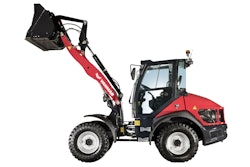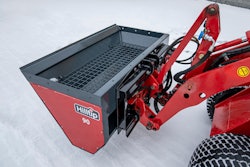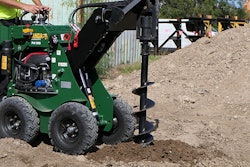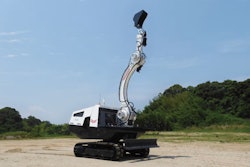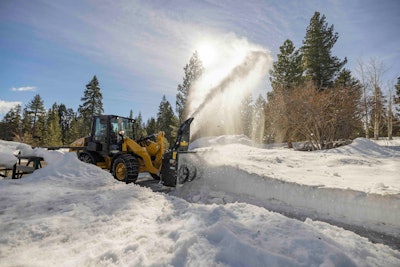
Manufacturers have worked hard to make compact wheel loaders better at their traditional applications, but they’ve also expanded features to meet the demands of customers who want more versatility.
Robbie Southerland, Caterpillar compact wheel loader product specialist for North America, says compact wheel loaders have distinct advantages over other compact equipment.
“They are versatile, easily configurable, upgradable and have a long service life, often having three or four owners over the life of the machine.”
For loading applications, compact wheel loaders stand out with their higher efficiency and greater ground speed. These traits also support other applications when customers want to use their CWLs instead of other compact machines.
So is a CWL always the right choice?
No. Southerland offers three tips to help customers choose the right machine:
- First, as always, is the application. Do you need zero-turn? Are you working in tight spaces? Do your attachments require more hydraulic power than a CWL can provide? If so, consider another machine. But if you’re doing a lot of loading, or if you’re doing other work on a site with room to maneuver, the greater lift, carry and travel speed numbers favor a compact wheel loader.
- Second, what are your operator qualifications? A wheel loader comes with some familiarity because it has a steering wheel and pedals for brake and accelerator. In addition, the Cat 906, 907 and 908 have operator assist modes. These features make it easier for less-experienced operators.
- Third, consider value. What is your business? What utilization rate can you expect, or what rate do you need? CWLs have higher initial cost but also lower owning and operating costs, longer service life and greater residual value than other compact machines.
Gehl
 The Gehl 650 has a Yanmar engine rated at 64.4 horsepower and a hydrostatic transmission with two speeds forward and reverse. Maximum speed is 19 mph. Flow is 18 or 26 gpm for standard and optional high flow. Operating weight with cab and forks is 9,500 pounds.Gehl
The Gehl 650 has a Yanmar engine rated at 64.4 horsepower and a hydrostatic transmission with two speeds forward and reverse. Maximum speed is 19 mph. Flow is 18 or 26 gpm for standard and optional high flow. Operating weight with cab and forks is 9,500 pounds.Gehl
The Power-A-Tach mounting system simplifies attachment changes, while an optional three-way auxiliary circuit directs hydraulic flow to the front and rear and includes high-flow. An oscillating articulation joint provides 45-degree turn angles right and left and 10 degrees of oscillation in both directions. A multifunction joystick offers low-effort control.
Options for the AL650 and AL750 include an air suspension seat, LED work lights, Hydraglide ride control and a three-speed transmission with speeds up to 19 mph.
Hitachi
 The 44-gross-horsepower Hitachi ZW50-5B loader has a 9,350-pound operating weight, 0.8-cubic-yard standard bucket capacity, 5,530 pound-feet of breakout force, and limited-slip differentials. The HST control system allows smooth startups on slopes, and an inching/brake pedal delivers smooth deceleration and better control for precise work, the company says.Hitachi Construction Machinery Americas
The 44-gross-horsepower Hitachi ZW50-5B loader has a 9,350-pound operating weight, 0.8-cubic-yard standard bucket capacity, 5,530 pound-feet of breakout force, and limited-slip differentials. The HST control system allows smooth startups on slopes, and an inching/brake pedal delivers smooth deceleration and better control for precise work, the company says.Hitachi Construction Machinery Americas
- The ZW30-5B has 25 horsepower and a bucket capacity of 0.52 cubic yards.
- The ZW50-5B has 44 horsepower and a standard bucket of 0.8 cubic yards.
- The ZW80-5B has 66 horsepower and a standard bucket of 1.2 cubic yards.
“All three are engineered with the same reliability, safety and efficiency as our larger production loaders,” says Matthew Koester, wheel loader production manager, HCMA.
The full front glass contributes to the 360-degree visibility and allows the operator to see the front wheels and attachments, he says. Suspension seating provides operator comfort, enhanced by the oscillating rear axle, which also improves stability and traction when working on uneven terrain.
John Deere
 The new 184 G-Tier loader from John Deere has 44 net horsepower, a 10,670-pound operating capacity and bucket capacities of 0.9 to 1.4 cubic yards. The engine is a Tier 4 Final Yanmar mated to a hydrostatic transmission. Front and rear differentials are limited slip. Options include a skid steer style Quick-Tatch coupler and joystick with third-function mini joystick.John Deere
The new 184 G-Tier loader from John Deere has 44 net horsepower, a 10,670-pound operating capacity and bucket capacities of 0.9 to 1.4 cubic yards. The engine is a Tier 4 Final Yanmar mated to a hydrostatic transmission. Front and rear differentials are limited slip. Options include a skid steer style Quick-Tatch coupler and joystick with third-function mini joystick.John Deere
“As a reminder, G Tier is for customers who need Deere reliability and performance but don’t need premium features,” says Luke Gribble, solution marketing manager, John Deere Construction Equipment.
The 204 and 304 went from L Series to G Tier; the 184 G Tier is a new machine. These CWLs are good with buckets and forks but also with grapples and other standard-flow attachments.
High flow is available on the 324 P Tier, which also has a high-lift option and offers more features than the G Tier models.
Regardless of Tier, customers can spec’ either skid steer-type quick-attach or European-style pin-grabber couplers.
Deere offers toolcarrier linkages on larger wheel loaders, “but the demands of toolcarriers are typically beyond the weight, power and hydraulic performance of compact models,” says Gribble.
He also hastens to point out that although G Tier models are more basic, Deere has made significant improvements to them, especially in the cab. The left-side door is now full glass. The right-side window swings 180 degrees and latches open. Glass on both the left and right of the steering column has been extended to the floor.
Kubota
 The Kubota R640 has a Kubota engine rated at 61.1 net horsepower. Auxiliary flow is 17.8 gpm at 2,973 psi. Standard bucket capacity is 0.93 cubic yards. New features include a high-visibility cab with enlarged front glass and full-size right-side window, delta-shaped loader arms for improved visibility and greater strength and rigidity, and LED work lights as standard equipment.Kubota
The Kubota R640 has a Kubota engine rated at 61.1 net horsepower. Auxiliary flow is 17.8 gpm at 2,973 psi. Standard bucket capacity is 0.93 cubic yards. New features include a high-visibility cab with enlarged front glass and full-size right-side window, delta-shaped loader arms for improved visibility and greater strength and rigidity, and LED work lights as standard equipment.Kubota
“We’ve also made a number of changes to improve the operator experience,” says Bill Holton, Kubota product manager, construction equipment. The console has been reconfigured; it and the switch layout have been moved to the right side to provide more foot and leg room while keeping all controls at fingertip access. The standard multifunction control lever selects forward-neutral-reverse and engages the differential lock.
Visibility has also been improved. The front window has been enlarged. The right-side window is now full glass and is the same size as the entrance door. Arms have been reconfigured for better visibility of buckets, forks and attachments. That improved visibility combined with the standard auxiliary port switch make attachment change-outs and operation easier, the company says.
Mecalac
 The Mecalac AX1000 has 75 horsepower, an 11,927-pound operating weight and bucket capacities of 1.3 to 2.1 cubic yards. Both axles have manually switched differential locks. Top speed is 12 mph. Optional equipment includes an 18 mph version, M-Drive hand throttle with inching pedal, LED work lights front and rear (either or both) and boom suspension.Mecalac
The Mecalac AX1000 has 75 horsepower, an 11,927-pound operating weight and bucket capacities of 1.3 to 2.1 cubic yards. Both axles have manually switched differential locks. Top speed is 12 mph. Optional equipment includes an 18 mph version, M-Drive hand throttle with inching pedal, LED work lights front and rear (either or both) and boom suspension.Mecalac
The 75-horsepower AX1000 is its best-selling model. Mecalac has four categories of wheel loaders: traditional articulated, such as the AX1000; swing loaders; telescopic loaders and rigid-frame loaders, the latter two with four-wheel, three-mode steering.
The AX1000 features the clean-sheet Monoboom design that is strong and improves visibility. The standard bucket is 1.3 cubic yards, although buckets of up to 2.1 cubic yards can be fitted. The self-stabilizing center-pivot (Mecalac Self Stabilizing Concept) improves handling and stability.
Mecalac chose the low-noise Deutz TD 2.9 L4 turbo diesel engine for the AX1000. Travel speed is 19 mph. Lift capacity is greater than 5,000 pounds, even at full articulation.
“We acknowledge that in many categories of equipment, our extensive engineering advantages and unique design features put Mecalac at the upper end of cost,” says Peter Bigwood, general manager, Mecalac North America. “But our traditional articulated wheel loaders are configured to meet the needs of the broadest range of customers, not those receiving benefit from advanced features. As such, these loaders are very cost competitive.”
Paus
 The 74-horsepower Paus TL 9065 has a 1.3-cubic-yard standard bucket and a 14,319-pound operating weight. The telescopic boom provides a maximum hinge pin height of 16 feet 5 inches and has a massive, twist-free steel frame to resist torsional loads even when using attachments. Options include joystick steering, 220V engine preheater, backup camera and LED work lights.miniloaders.com
The 74-horsepower Paus TL 9065 has a 1.3-cubic-yard standard bucket and a 14,319-pound operating weight. The telescopic boom provides a maximum hinge pin height of 16 feet 5 inches and has a massive, twist-free steel frame to resist torsional loads even when using attachments. Options include joystick steering, 220V engine preheater, backup camera and LED work lights.miniloaders.com
“We are now also bringing in Paus loaders from Germany,” says Chris Sleurink of Miniloaders.com. “We’re currently doing the first demos.”
The 75-horsepower TL 9065 is the one compact model. The standard bucket is 1.3 cubic yards. A multifunction joystick and proportional control provide ease of use when loading or operating attachments. Options include high-speed travel of 24.8 mph, a second hydraulic circuit with 21 or 31 gallons per minute of flow, and PTO for attachments not paired with the standard hydraulic four-point quick-change coupler.
Also standard on Paus wheel loaders is a telescopic boom “and from March 2024 onward, we’ll have swing boom variants, as well,” says Sleurink.
Volvo
 The Volvo L20 and L25 Electric (shown) wheel loaders received a number of upgrades late in 2022. Maximum speed was increased to 12.4 mph, a parallel linkage option was added, and charging architecture was improved. Operator comfort is enhanced with lower in-cab noise levels and a new programmable cab heater option to preheat and defrost the cab. Standard bucket size is 1.17 cubic yards, operating weight is up to 11,618 pounds, and battery capacity is 40 kWh.Volvo CE
The Volvo L20 and L25 Electric (shown) wheel loaders received a number of upgrades late in 2022. Maximum speed was increased to 12.4 mph, a parallel linkage option was added, and charging architecture was improved. Operator comfort is enhanced with lower in-cab noise levels and a new programmable cab heater option to preheat and defrost the cab. Standard bucket size is 1.17 cubic yards, operating weight is up to 11,618 pounds, and battery capacity is 40 kWh.Volvo CE
Charging from zero to 100% takes about six hours with the 6 kW onboard charger when using a 240V service or Level 2 charging station, which is the most common EV charging setup.
Maximum speed is 12.4 mph. An electric parking brake also provides automatic hill-hold. Compared to a traditional disc brake, the spring-applied, hydraulically released wet disc brake improves performance and reduces maintenance costs.
Total cost of ownership for an eCWL is lower than for an equivalent diesel model, despite the higher initial purchase cost. Obvious savings result from not requiring diesel fuel, engine oil, filters and related items.
But there’s also potential for jobs where noise and emissions restrictions favor electric models. “The ability to not disturb others in densely populated areas and to work indoors allows owners to bid on jobs from which they would otherwise have been excluded,” says Darren Ashton, product manager - compact equipment, Volvo Construction Equipment.
Idle time is another factor, as there is none with an electric machine. It’s on when it’s working and off when it’s not, and accumulated hours reflect this. Lower hours result in higher residual value in the secondary market.
Wacker Neuson
 The Wacker Neuson WL52 has a Deutz TCD 2.9 L4 turbo diesel engine rated at 74.3 horsepower. Operating weight with cab is 11,244 pounds, and standard bucket capacity is 1.1 cubic yards. Auxiliary flow is 19.4 gpm with a 30.4 gpm option; pressure is 3,016 psi. The joystick console is mounted on the operator’s seat and is cushioned to minimize vibration.Wacker Neuson
The Wacker Neuson WL52 has a Deutz TCD 2.9 L4 turbo diesel engine rated at 74.3 horsepower. Operating weight with cab is 11,244 pounds, and standard bucket capacity is 1.1 cubic yards. Auxiliary flow is 19.4 gpm with a 30.4 gpm option; pressure is 3,016 psi. The joystick console is mounted on the operator’s seat and is cushioned to minimize vibration.Wacker Neuson
The drive system is electronically controlled, and control switches are color coded for easy reference. Auto and Eco modes are standard, while optional Attachment mode can be spec’ed to match intended use. Attachment mode prioritizes power to the front auxiliary attachment to maintain consistent flow and hydraulic power to the work tool.
Besides the new WL28, Wacker Neuson’s compact wheel loader line includes the WL34, WL38 and WL52 with 34, 74 and 75 horsepower, respectively.
“Operator comfort is the foundation of wheel loaders’ design,” says Jay Quatro, commercial product manager, Wacker Neuson. Comfort features include mechanically suspended and heated air-ride seat options, adjustable wrist rests and tilting and telescoping steering wheels. “These all help maximize comfort and minimize fatigue.”
Yanmar
 The 72-net-horsepower Yanmar V10 has an operating weight of 12,786 pounds and bucket capacities of 1.31 to 2.03 cubic yards. Maximum pump capacity is 20.3 gpm, and maximum working pressure is 3,626 psi. Standard top speed is 12.4 mph; a 22.4 mph HS option is available. Standard features include air conditioning, battery disconnect, two work lights each front and rear, and steering wheel with height and tilt adjustment.Yanmar
The 72-net-horsepower Yanmar V10 has an operating weight of 12,786 pounds and bucket capacities of 1.31 to 2.03 cubic yards. Maximum pump capacity is 20.3 gpm, and maximum working pressure is 3,626 psi. Standard top speed is 12.4 mph; a 22.4 mph HS option is available. Standard features include air conditioning, battery disconnect, two work lights each front and rear, and steering wheel with height and tilt adjustment.Yanmar
Yanmar also offers the 39-horsepower V4-7 and recently announced the new V7 CWL.
He says snow removal is the market showing the greatest growth. The V10’s horsepower and 22 mph travel speed are good matches for that. Even so, customers are looking for more hydraulic performance, in the range of 28 to 30 gallons per minute, for bigger attachments; the V10 has 20.3 gpm.
Yanmar used Deutz engines in their three compact wheel loaders until a few years ago, “but we’re justifiably proud of the reliability and performance of our own engines and made the switch,” says Gangi. The company also switched from bright yellow to red exteriors around that time.
 The Case 221F has an FPT engine rated at 74 gross horsepower. Standard flow is 22.5 gpm at 3,336 psi; a high-flow option provides 34.3 gpm at 2,901 psi. The hydrostatic transmission provides 11.4 mph forward and reverse or 18.6 mph forward and reverse with the optional three-speed HS spec.Case Construction Equipment
The Case 221F has an FPT engine rated at 74 gross horsepower. Standard flow is 22.5 gpm at 3,336 psi; a high-flow option provides 34.3 gpm at 2,901 psi. The hydrostatic transmission provides 11.4 mph forward and reverse or 18.6 mph forward and reverse with the optional three-speed HS spec.Case Construction Equipment




